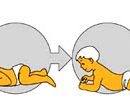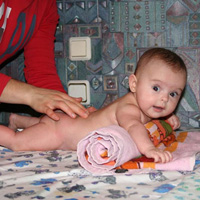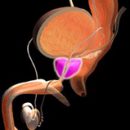A terrible diagnosis of hydrocephalus sounds like a sentence, but few people know that this disease is healing, and the earlier treatment has begun, the better the outcome.
Content
What is hydrocephaliya?
Hydrocephalus — This is an excess accumulation of fluid contained in the cavities of the brain and the spinal channel. Hydrocephalus is congenital and acquired. It occurs when impaired suction, excess formation of fluid in the cavities of the brain and the difficulty of its outflow, for example, with tumors, spikes after the inflammatory process.
Signs of hydrocephaliya
 The state is manifested by signs of increasing intracranial pressure: headache (first), nausea, vomiting, violation of various functions: hearing, vision (the last 3 signs may not be absent). Young children spans the spring. Depending on the cause that caused the disease, other symptoms arise.
The state is manifested by signs of increasing intracranial pressure: headache (first), nausea, vomiting, violation of various functions: hearing, vision (the last 3 signs may not be absent). Young children spans the spring. Depending on the cause that caused the disease, other symptoms arise.
Distinguish the sharp and chronic phases of the disease. In the acute stage, symptoms of the underlying disease, caused by hydrocephalus, in chronic — Signs of the hydrocephalus itself, which in the absence of treatment progresses. The disease can develop and intrauterine, in this case they talk about congenital hydrocephalus.
Children are born with a big head (up to 50-70 cm in a circle at an average of about 34-35 cm), in the case of the progression of brain water, the skull circle can become even more. At the same time, takes the shape of a ball with an outstanding forehead, the spring is incremented in size, empty, the bones of the skull become thinner, the cranial seams diverge.
There is a delay in the physical development of the child — Later begins to keep their heads, sit, walk, there is a weakness of limbs, predominantly legs, visual acuity decreases, often epileptic seizures, children are lagging behind in mental development. In the future, after the closure of spring, headaches appear, vomiting, as well as various symptoms, the character of which depends on the location of the obstacle that disrupts the outflow of the spinal fluid.
Treatment of hydrocephaliya
In the acute phase, funds that reduce intracranial pressure are prescribed (Laziks, mannitis, glycerin), removal of small amounts of spinal fluid by puncture (puncture) in the field of springs in order to reduce intracranial pressure. In the future, constant observation and treatment of a neuropathologist.
In some cases, resort to surgical intervention — eliminating the causes of the disturbance of the outflow of the spinal fluid or to the operation, as a result of which the spinal fluid is constantly reset to the heart cavity or abdominal cavity, and other surgical methods. Without treatment, most children remain severely disabled or digest at an early age.
Treatment is aimed at reducing and stabilization of intracranial pressure. In the outpatient conditions, depending on the etiology of hydrocephalus, a lining therapy, salt-conifers, dehydration, desensitizing and anti-inflammatory therapy are shown. Applied diakarba, which is prescribed with potassium preparations (to preserve adequate electrolyte balance). Diakrab treatment is carried out continuously and for a long time. The lack of a favorable effect in conservative treatment is an indication to the direction of the patient in the hospital.
Surgical treatment is contraindicated in the stabilized form of hydrocephalus, the current inflammatory process in the brain and its shells, in the far-seated stage of hydrocephalius, in the presence of blindness, irreversible neurological and mental disorders, severe hypotrophy and cachexia, in inflammatory diseases of the internal organs. Operations are palliative and radical. Palliamental includes a cerebrospinal puncture, which is shown in open hydrocephalus, and a ventricular puncture used in closed form, as well as a number of other operations, in particular, the outer drainage in acute occlusive syndrome. Operations are 3 types. Universal operations produced with any form of hydrocephalus. These include ventriculotomomomy and ventriculipperitoneostomy, as well as ventriculoseterostomy.









